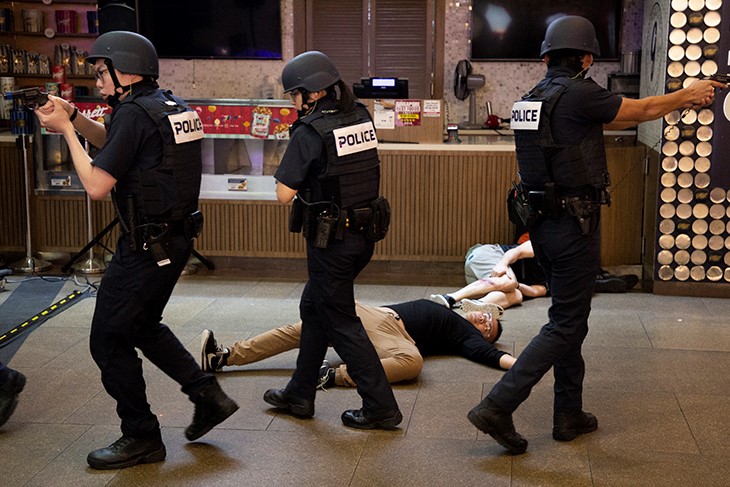Since the emergence of COVID-19, the Home Team has moved swiftly to support the national response to this public health threat. Here’s a snapshot of how our Home Team Guardians are playing their part.
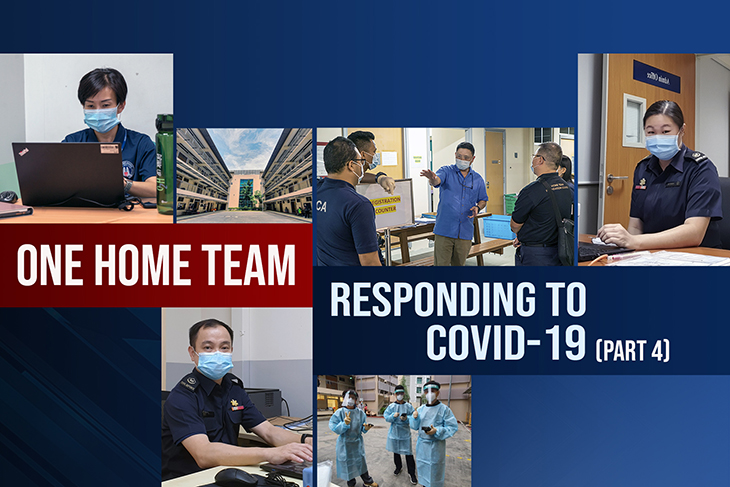 SWIFT ACCOMODATION
Superintendent (SUPT) 1A Tanny Ng, Home Team Academy (HTA)
SWIFT ACCOMODATION
Superintendent (SUPT) 1A Tanny Ng, Home Team Academy (HTA)
Before receiving the call that would completely rewire her working hours, SUPT 1A Tanny Ng was already preparing herself for the challenges brought about by COVID-19. As Watch Commander of HTA’s foreign worker dormitory operations (in support of the national effort to relocate foreign workers staying in dormitories to alternative accommodations), she's committed to ensuring the well-being of dormitory residents and her team.
What was the transition like from your usual role at HTA to your current role as Watch Commander?
I was seconded from the
Singapore Prison Service to HTA as Deputy Director (Cross-Cutting Skills) of the Centre for Home Team Skills Transformation, prior to my activation as Watch Commander. As a Prison officer, I was familiar with operations as well as the reception and discharge process. However, as our operations team was activated at short notice, we faced some initial challenges. Within three days, we had to establish key processes such as manpower deployment, registration for the arriving dormitory residents and database instructions. Many of us worked beyond 24 hours straight during this initial period as we transited from “peacetime” to full operations.

SUPT 1A Tanny (middle photo, at left) with her team members; and at right. PHOTOS: HTA
What did your team work on?
As Watch Commander, my primary responsibility is to ensure that the dormitory residents and our staff are safe and that there is cohesiveness within the team. After establishing our key processes and SOPs, we proactively engaged the dormitory residents and their employers to find out their needs and concerns. With this input, we quickly finetuned our processes as we believed that this would help reduce any anxiety that the residents might have. With the support of our Centre for Learning Systems colleagues, we also developed a programme to accurately maintain the residents’ relevant records and track the incoming and outgoing movements. This facilitated the prompt reporting of accurate figures to management and the relevant Government agencies.
Besides having to set up operations quickly, what other challenges did you face, and how did you overcome them?
As HTA isn’t a purpose-built facility for managing isolated cases, we had to develop measures that are in line with
Ministry of Manpower and
Ministry of Health guidelines to minimise the risk of transmission. For example, one solution was to have segregated cubicles and taps in the toilets for residents. Other challenges we faced included the language barrier and making sure that residents understood the importance of observing safe distancing measures. HTA’s Corporate Communications team stepped in by developing posters and advisories in the native languages of the residents.

Welcoming residents to HTA. PHOTOS: HTA
You mentioned that one of your responsibilities is to maintain cohesiveness within the team. How do you do this?
I regularly find time to engage with our staff on the ground, to find out how they’re coping with work and at home. Typically, I’ll do this during the night shift when there’s less movement of people within HTA. Such check-in sessions help me to identify any issues early, so that we can address them together.
We also have group chats to keep everyone updated on the latest news regarding the residents, share self-care tips and encourage one another. At times, to energise my team (and because we Singaporeans are foodies), I’ll buy them nice snacks. So, there’s an innate sense of camaraderie within our team.
I experienced an especially heart-warming moment on Mother’s Day when my team wished me a resounding “Happy Mother’s Day” before I went home. As the only woman officer on the team, I was touched by their gesture.
What’s a surprising takeaway you’ve had on the job?
As I mentioned, the team was activated at short notice and is mainly composed of seconded Home Team officers to HTA and also the co-located Home Team training schools who were generally unfamiliar with one another. So I was pleasantly surprised at the strong rapport that was quickly established among the officers. It was “One Home Team” in operation!
– INTERVIEWED BY RACHEL SIN
LIKE HOME
Marcus Chow, Assistant Director (Security), HTA
To help manage COVID-19 cases within the foreign worker community, certain dormitories at HTA and the
Civil Defence Academy have been converted into temporary housing facilities for foreign workers. Assistant Director (Security) of HTA Marcus Chow explains how he and his team have helped to oversee their safety and security on-site.
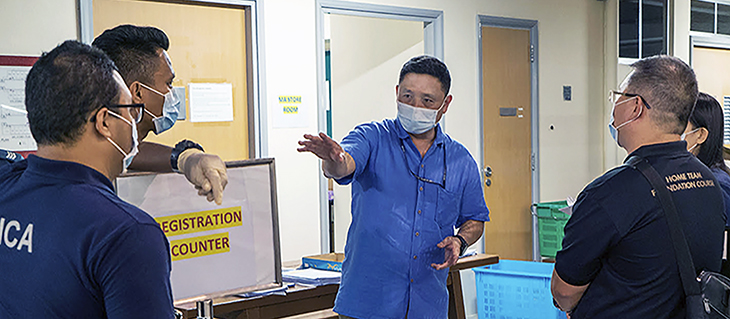
Marcus Chow (at centre) works with his team to ensure the safety and welfare of the residents under his care. PHOTO: HTA
What are the arrangements to accommodate the residents?
It was a whole-of-HTA effort in collaboration with the Home Team Training Schools. We make sure that the living quarters are clean and in good condition and that the safety of the residents is taken care of at all times.
We also wanted the residents to feel comfortable, so, with the help of HTA’s Corporate Communications team, we prepared illustrated posters in English, Bengali and Tamil and displayed them on the dormitory doors. The posters remind residents to practise personal hygiene and safe distancing. Ultimately, our aim is to create living spaces that felt like home.
What are your duties on a daily basis?
We ensure the well-being of the residents and their safety, and that their meals are provided for, taking into consideration their dietary requirements. We also make sure the residents have access to Wi-Fi and help with their logistical needs, like providing them with pails and detergent for laundry. We also support their requests to contact their employers and also arrange to send them for medical checks when needed.
What have you learnt from this experience?
It has been meaningful as it’s a cause that’s beyond our regular operations; the work we’re doing now is part of a national effort. Ultimately, the foreign workers have contributed to Singapore, so it’s the least that we can do, to give back now. Finally, without a doubt, it’s the camaraderie of the entire team at HTA and the Home Team Training Schools that’s integral to making all of this work.
– INTERVIEWED BY FAZLEE ROSLI
PROTECTING THE PROTECTORS
First Warrant Officer (WO1) Genevie Tan, Senior Medic, HTA Medical Centre, Singapore Civil Defence Force (SCDF); and WO1 Kent Goh, Senior Medic, CDA Medical Centre, SCDF
MHA’s Home Team Medical Services Division (HTMSD) has worked hard to implement measures at our Medical Centres to ensure the safety and health of our Home Team officers and NSFs. Managing the new workflow are WO1 Genevie Tan at the HTA Medical Centre and WO1 Kent Goh at the CDA Medical Centre. They share how they’ve responded to the COVID-19 situation.
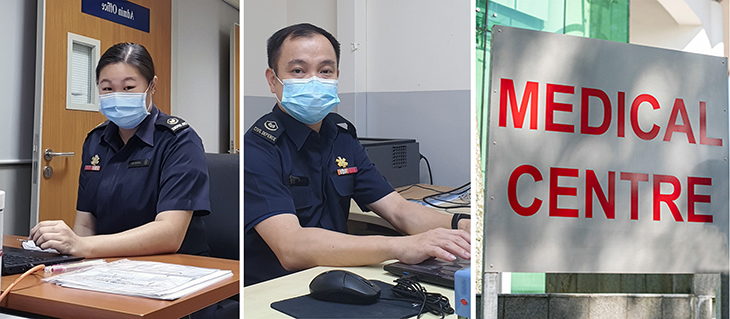
WO1 Genevie Tan (left) and WO1 Kent Goh (centre). PHOTOS: Fazlee Rosli, HTMSD
How has your work evolved since the COVID-19 outbreak?
WO1 Genevie: There’s definitely a change from how we were operating. Now, we forward-triage every patient who enters the Medical Centre, conduct temperature screenings and record the particulars of all visitors, in case contact tracing is needed. At HTA, we’ve also cordoned off certain areas around the Medical Centre, put up relevant posters and signage and set up an isolation area (and a dedicated mobile toilet) for suspected COVID-19 cases. Staff attending to suspected cases in the isolation area will don full Personal Protective Equipment (PPE).
WO1 Kent: We’re mindful about how we handle patients when they visit the CDA Medical Centre and adhere to safe distancing guidelines. We also actively look out for suspected COVID-19 cases to segregate them from other patients. At CDA, we’ve also established an isolation area to separate suspected cases from other patients. The doctor will attend to these patients in full PPE. If needed, an ambulance will be activated to convey patients to the
National Centre for Infectious Diseases for further tests.
How does the COVID-19 situation compare to past challenges you’ve faced?
WO1 Genevie: This is the first time we are facing a public health challenge of this magnitude, and the situation is very fluid. But I constantly keep myself updated on the latest information and advisories, so I can respond to the situation effectively.
WO1 Kent: I was already in service during the SARS pandemic in 2003 and I remember feeling very confident that we’d pull through. Our focus is to ensure the health and safety of our officers.
– INTERVIEWED BY FAZLEE ROSLI
Thanks to our dedicated Home Team Guardians for keeping Singapore safe and secure. Don’t forget to check out:
-
One Home Team: Responding to COVID-19 (Part 1)
-
One Home Team: Responding to COVID-19 (Part 2)
-
One Home Team: Responding to COVID-19 (Part 3)
-
One Home Team: Responding to COVID-19 (Part 5)
-
One Home Team: Responding to COVID-19 (Part 6)
-
One Home Team: Responding to COVID-19 (Part 7)






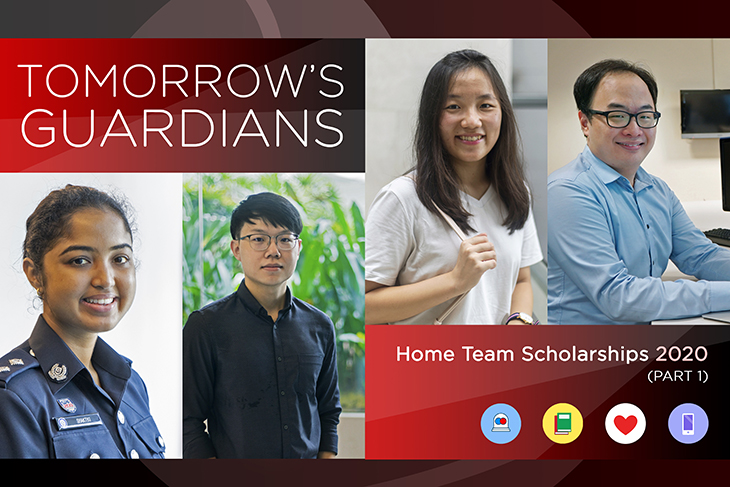
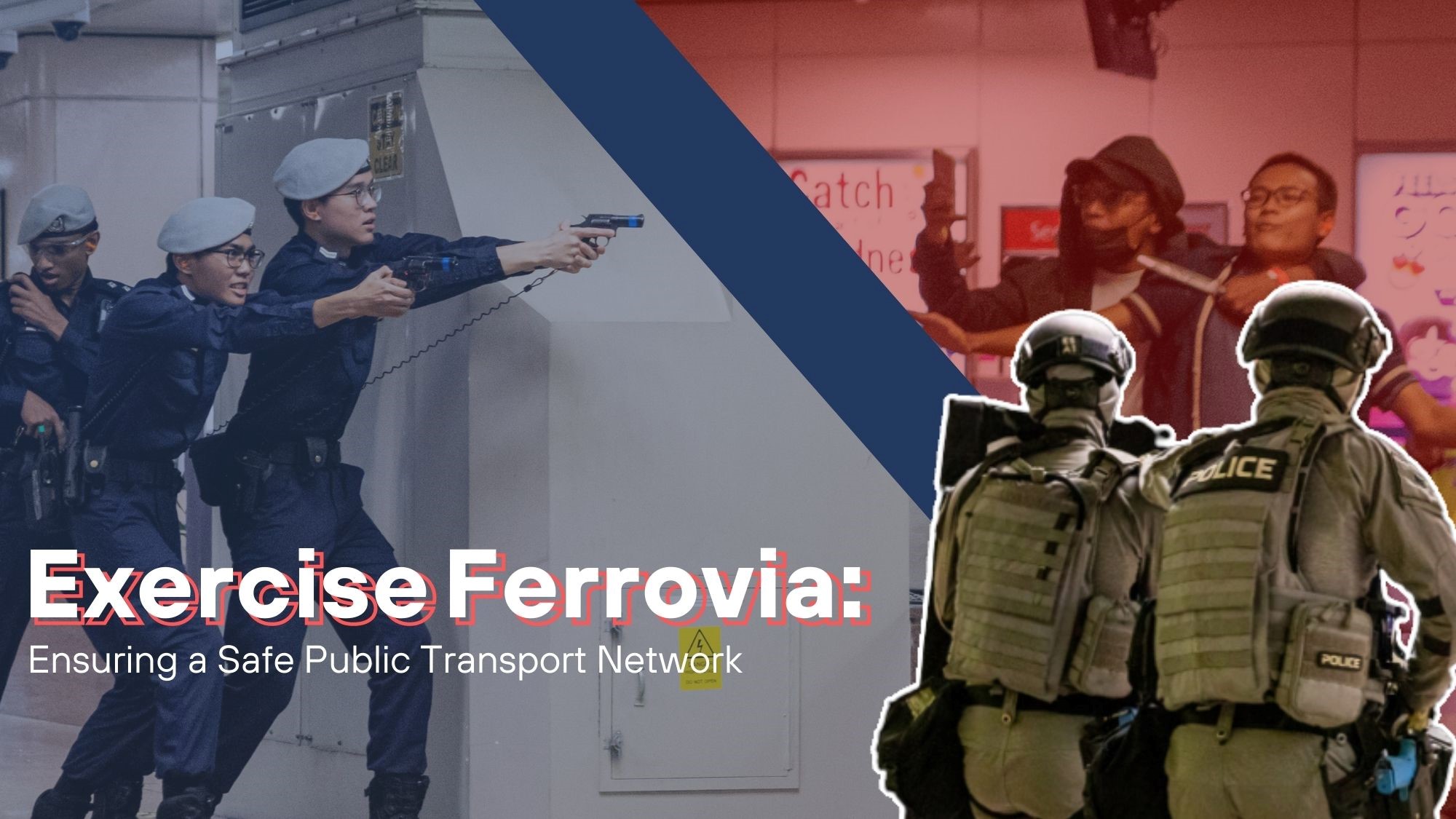
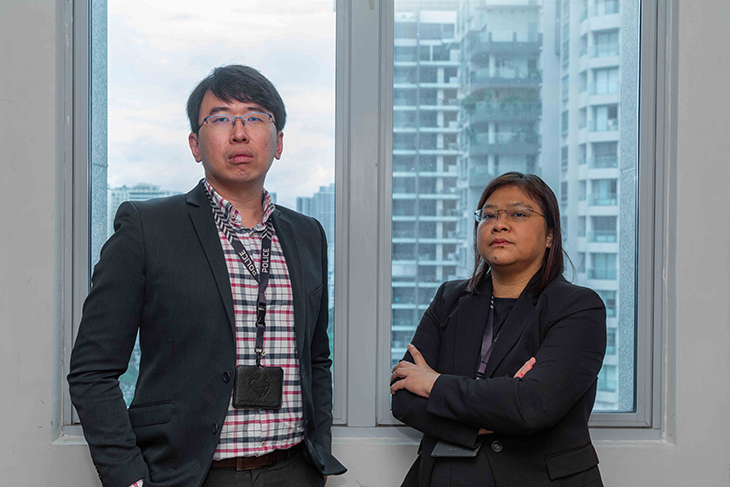
.jpg?sfvrsn=e1ae8cf0_0)
